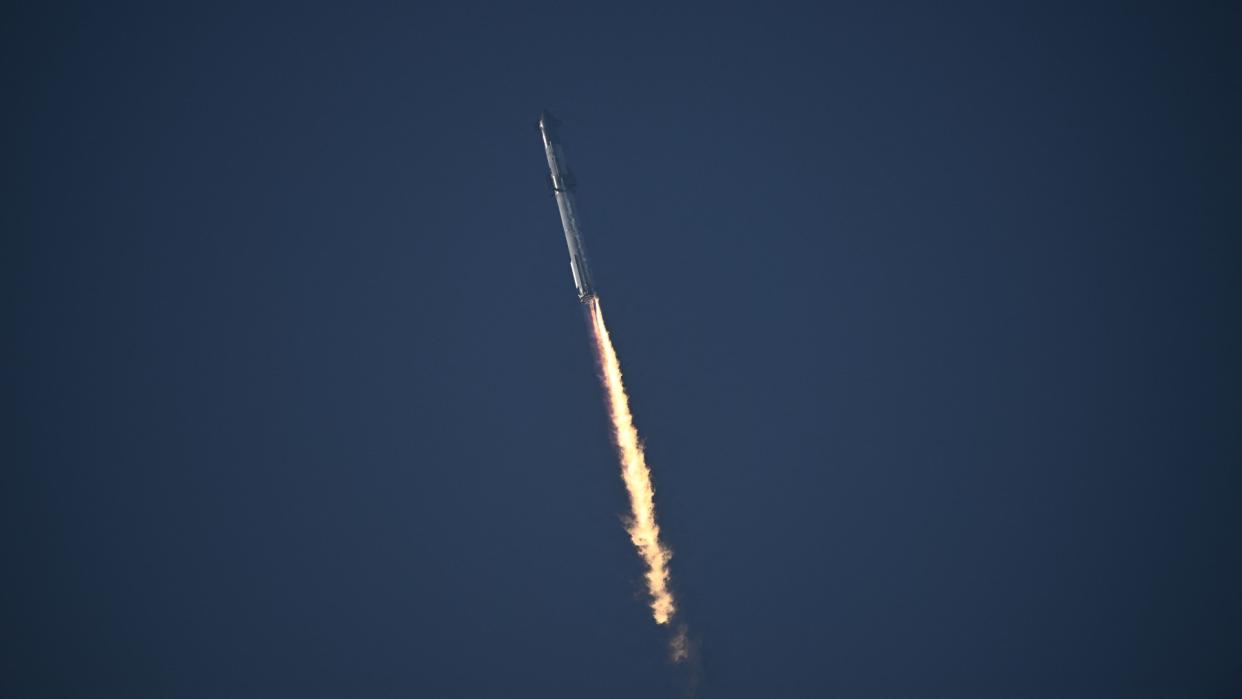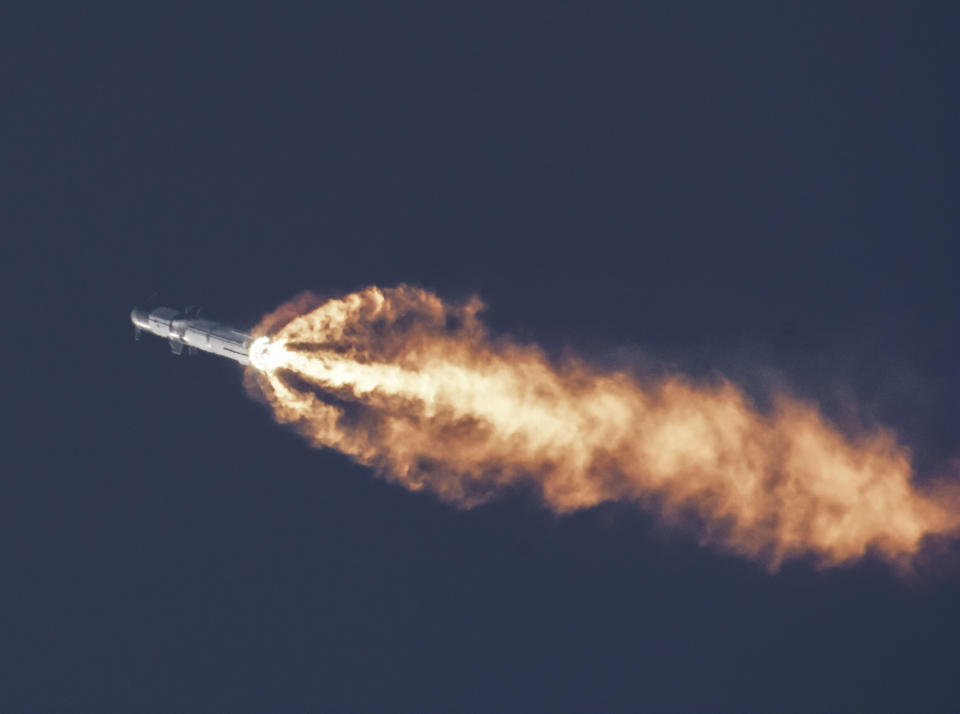Watching SpaceX's Starship launch as the world's largest rocket felt simply unreal (video)

SOUTH PADRE ISLAND, Texas — First, there was the fire. Then came the sound. A mighty, mighty sound.
When SpaceX's Starship spacecraft launched into the sky atop its massive Super Heavy booster today (April 20), the spectacle was unmistakable. At ignition, dozens of Raptor engines belched brilliant, hot flame from their methane-fueled maws as cheers erupted from the throngs of spectators lining the beach here.
But Starship was quickly engulfed by its own exhaust and the crowd began to wonder: Did it abort? Is it still there? You know, all those questions that come to mind when a rocket doesn't lift off as planned.
Yet, there it was, moving ever so slowly: Starship's nose peeking up out of the exhaust and followed by nearly 40 stories of stainless steel as the 394-foot-tall (120 meters) SpaceX megarocket — the largest ever built — climbed off the pad. The crowd, understandably, went wild.
Related: SpaceX Starship's explosive test flight: What did we just see?
More: Incredible photos of SpaceX's 1st Starship launch

The sound alone was unlike anything I've ever heard before, shaking me to the core as Starship attempted to leave Earth (unsuccessfully, it would turn out). The engine plume was a brilliant torch, sputtering as Starship and Super Heavy arced across the blue sky, losing a few engines on the way.
In SpaceX's live video feed, it was clear that three of Super Heavy's 33 Raptor engines didn't work as planned at liftoff. A fourth engine died 40 seconds into flight, and a fifth dropped out at the one-minute mark. None of that was apparent from the ground here, where media and the public watched from 5 miles (8 kilometers) away at the South Padre Island amphitheater.
Just past two minutes into the flight, Starship and Super Heavy began tumbling, which was apparent in live views from the rocket and to the photographer next to me with his camera locked on the rocket. "Oh, sh**!" he kept saying, dropping an F-bomb as Starship lost control. Three minutes after liftoff, I couldn't see Starship anymore in the mid-morning sky, but what happened next was obvious.
Related: The best SpaceX Starship merch on Amazon
Four minutes into the flight, Starship and Super Heavy exploded. Their flight termination system, designed to blow up both vehicles in an emergency, triggered high above the Gulf of Mexico, leading to a flare and debris cloud in the sky that even I could see. "Ooooo….." the crowd exclaimed in a collective wince like you'd hear during a particularly bad wipeout in a surfing contest.
There's no denying that SpaceX's first Starship launch failed to reach space. But as debut flights go, it's far from a complete failure. After all, company founder and CEO Elon Musk never promised a successful flight. Only "excitement guaranteed," as he put it. The launch was a test mission, and one SpaceX will learn from as it did when trying to land and reuse Falcon 9 rockets, something that's routine these days.
That the rocket got off its pad in one piece was amazing. The same can't be said for the pad itself, which apparently has a new crater under its pad mount from Super Heavy's flames. Video shared on Twitter show the pad strewn with debris, some of which slammed into a nearby car left parked at the launch site for some reason.
SpaceX will likely have to revisit its decision not to dig a flame trench like the one beneath NASA's Space Launch System megarocket, which briefly scored the title of world's most powerful rocket when it launched the Artemis 1 moon mission in November before Starship snatched it away today. How long it takes to clean and repair Starship's pad could affect SpaceX's schedule for future tests. The company has already assembled several more Super Heavy boosters and Starships. (I saw them in Starbase's hangar the night before launch.)
The Starship that flew today was the first of a new wave of reusable giant rockets that could open the solar system to sustained exploration. NASA has picked Starship to land its Artemis 3 astronauts on the moon in 2025, just two years from now (though that timeline is fairly ambitious and could slip). Did NASA slam SpaceX for the launch failure? No.
"Every great achievement throughout history has demanded some level of calculated risk, because with great risk comes great reward," NASA chief Bill Nelson said via Twitter after the test. "Looking forward to all that SpaceX learns, to the next flight test — and beyond."

Related stories:
— Starship and Super Heavy: SpaceX's Mars-colonizing transportation system
— Elon Musk says SpaceX could launch a Starship to the moon 'probably sooner' than 2024: report
— SpaceX's 1st orbital Starship looks supercool in these fueling test photos
SpaceX has also sold three private flights on Starship, the first to billionaire Jared Isaacman for his Polaris program. The others include a trip around the moon for Japanese billionaire Yusaku Maezawa, who has picked a team — including space YouTuber Tim Dodd, the Everyday Astronaut — to join him, as well as a separate flight that includes Dennis Tito, the world's first space tourist. So Starship is coming, one way or another, maybe just not on Elon Musk's ambitious schedule.
One other thing that's clear: Starship is captivating. On the eve of Thursday's launch, hundreds of SpaceX and rocket fans flocked to Boca Chica Beach on a road that runs right by Starship's launch pad, where they parked their cars and basked in sunset views of the giant rocket.
"It's just one of my childhood dreams coming true, like we actually have a freaking rocket that's bigger and stronger than the Saturn V," Bill Allsen of Dallas told me as we stood across the street from Starship, literally, while waiting for sunset. "We're going back to the moon. We're eventually going to go to Mars. It's freaking unbelievable."
Tariq Malik is the Editor-in-Chief of Space.com. Follow him on Twitter @tariqjmalik. Follow us on Twitter @Spacedotcom or Facebook.

